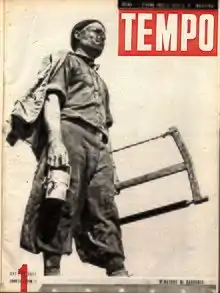Tempo (Italian magazine)
Tempo (meaning Time in English) was an Italian language illustrated weekly news magazine published in Milan, Italy, between 1939 and 1976 with a temporary interruption during World War II.
 | |
 Cover of the first issue, June 1939 | |
| Former editors | Alberto Mondadori Indro Montanelli |
|---|---|
| Categories | News magazine |
| Frequency | Weekly |
| Year founded | 1939 |
| First issue | 9 June 1939 |
| Final issue | 1976 |
| Company | Mondadori Palazzi |
| Country | Italy |
| Based in | Milan |
| Language | Italian |
| ISSN | 1128-2959 |
| OCLC | 436686743 |
History and profile
Tempo was first published on 9 June 1939,[1][2] being the first full colour illustrated Italian magazine.[3] The founding company was Mondadori.[2][4] The magazine was modelled on the American magazines Life[2] and Newsweek.[5]
Tempo was edited by Alberto Mondadori, son of Arnoldo Mondadori.[6][7] Indro Montanelli was the first editor-in-chief of the magazine.[6] From its start in 1939 to September 1943 Bruno Munari served as the art director for the magazine and for another Mondadori title, Grazia.[8] The early contributors for Tempo were Massimo Bontempelli, Curzio Malaparte,[9] Lamberti Sorrentino, and Salvatore Quasimodo.[10] The magazine also included the work by photographers John Philiphs who previously worked for Life, and Federico Patellani.[10]
The headquarters of Tempo was in Milan.[11] Major sections of the magazine included politics, news, literature and art.[3] Although it was modeled on Life, unlike it Tempo covered much more political topics.[3]
By 1942 Tempo had editions published in eight different languages,[2] including Albanian, Croatian, French, Greek, Rumanian, Spanish, German and Hungarian.[6] On 8 September 1943 the magazine stopped publication following the occupation of northern Italy by German army during World War II.[3][10] In 1946 Mondadori sold the magazine to Aldo Palazzi.[9] Then the magazine was relaunched and was both owned and published by Palazzi.[11][12] During this period it held a centrist political stance.[11]
In the 1960s Tempo frequently carried political and news articles with moderate and conservative tones.[13] In 1976 the magazine ceased publication.[14]
References
- "1940s/1950s/Early 1960s Italian People's Magazines". Listal. Retrieved 25 April 2015.
- Guido Bonsaver (2007). Censorship and Literature in Fascist Italy. University of Toronto Press. p. 234. ISBN 978-0-8020-9496-4.
- Alessandro Colizzi (Spring 2013). "Milan's anarchic Modernist". Eye Magazine. Retrieved 25 April 2015.
- "Arnoldo Mondadori Editore S.p.A. - Company Profile". Reference for Business. Retrieved 25 April 2015.
- Adam Arvidsson (2003). Marketing Modernity: Italian Advertising from Fascism to Postmodernity. New York: Routledge. p. 23. – via Questia (subscription required)
- Ignazio Weiss (May 1960). "The Illustrated Newsweeklies in Italy". International Communication Gazette. 6 (2). Archived from the original on 9 April 2015. Retrieved 9 April 2015.
- David Forgacs; Stephen Gundle (2007). Mass Culture and Italian Society from Fascism to the Cold War. Indiana University Press. p. 103. ISBN 978-0-253-21948-0.
- "Bruno Munari: art director, 1943-1944". Domus. 24 March 2012. Retrieved 25 April 2015.
- Sanna Kristiina Salo. "The propaganda discourses used by Oggi and Tempo in Italy during the right-wing power consolidation 1950-1953" (PDF). University of Oulu. Retrieved 27 April 2015.
- "La Rivista Tempo". Romano Archives. Retrieved 25 April 2015.
- Gabriella Ciampi de Claricini (February 1965). "Topical weeklies in Italy". International Communication Gazette. 11 (1): 12–26. Retrieved 25 April 2015.
- J. H. Schacht (March 1970). "Italian Weekly Magazines Bloom Wildly but Need Pruning". Journalism & Mass Communication Quarterly. 47 (1): 138–141. doi:10.1177/107769907004700119. S2CID 144061856.
- Laura Ciglioni (2017). "Italian Public Opinion in the Atomic Age: Mass-market Magazines Facing Nuclear Issues (1963–1967)". Cold War History. 17 (3): 205–221. doi:10.1080/14682745.2017.1291633. S2CID 157614168.
- "Publishing in Milan". Storie Milanesi. Retrieved 25 April 2015.